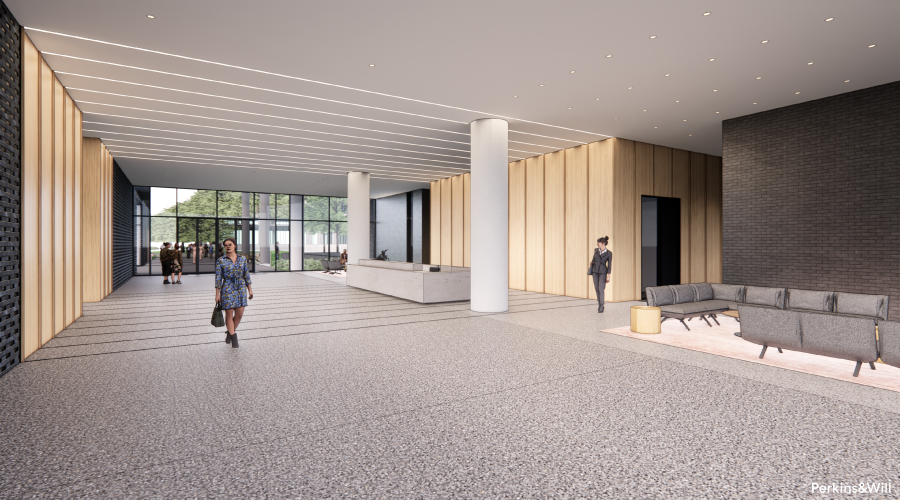
Perkins&Will
Using Behavioral Data to Design New Office Spaces
Behavioral data is being used to welcome employees back to the office. May 26, 2023
By Mackenna Moralez, Associate Editor
First coined in the 1930’s, the phrase “work smarter, not harder” has never resonated with people more than it does today. With the current influx of new technologies like the Internet of Things (IoT) and artificial intelligence (AI), employers are utilizing it to their advantage to get people back in the office.
As COVID-19 restrictions begin to ease, more commercial offices are encouraging their employees to come back to the office. However, these spaces are now being reconfigured with behavioral data so that employees can thrive at work. Using this data, designers can best provide solutions that fit the needs for people occupying the space, overall increasing employee satisfaction.
With more commercial offices welcoming back employees as COVID-19 restrictions ease, behavioral data is being used to design spaces for employees to thrive in. Using this data set, designers can best provide solutions that fit the needs for the people occupying the space.
FacilitiesNet recently spoke with Wyatt Frantom, Principal and Design Director, Perkins&Will Austin to discuss how behavioral data is being used in the spaces they create. This is part one of a two-part conversation.
FacilitiesNet: What kind of behavioral data do you collect to inform your design decisions? How can these insights help facilities managers in their daily role?
Wyatt Frantom: As a ‘research-informed practice’ that conducts ‘practice-informed research’, Perkins&Will utilizes behavioral data as an integral tool to inform design. Through a variety of methodologies such as user surveys, simulation, project benchmarking, practice area expertise, market trending, pre-occupancy facilities assessments, and post-occupancy evaluations, we gather behavioral insights that are necessary inputs to creating places for human-centered experiences.
We often find that facilities managers are already promoting the benefits of behavioral data by providing the type of smart building solutions that are required of our tech-enabled world. With our devices that follow us everywhere, plug-and-play technologies, and robust building management systems, the lines between our digital screens and our ‘in real life’ (IRL) built experiences are blurring. From the implementation of simple sensors for tracking occupant movement, lighting loads, or energy use to data mining the internet of things (IoT) within a space, built facilities are increasingly intelligent.
FacilitiesNet: Can you give an example of a project where you used behavioral data to inform your design decisions? What was the outcome?
Frantom: Most recently, our Austin studio employed behavioral data in design conversations with the Texas Facilities Commission (TFC) on Phase II of their North Austin Campus. Through user surveys and benchmarking from our global portfolio, we were able to quickly provide office test fits to flexibly accommodate a wide range of user types such as in-person employees, remote team members, in-field fleets, hoteling workers, cafeteria and café patrons across the campus, and training session attendees from across the state. Now in design development, the project accounts for both the uncertainty of the post-COVID workplace environment and, through future-casting scenarios, for the client’s projected growth and expansion.
Whether a ground-up building like the Phase II project, a reposition, tenant build-out, lease negotiation, or FFE procurement, designs that are informed by diverse behavioral data points in the context of a client’s specific circumstances result in solutions that can be appropriately “right-sized” to the specifics of their operations, and “tuned” to the nuances of their culture. This results in cost savings and employee satisfaction, recruitment, and retention. Rather than providing an ‘off-the-shelf ready-to-wear’ solution, in these data-rich times we can design workplaces that are flexibly made-to-measure.
In line with the Texas Facilities Commission’s aspiration of developing the next generation of office building on the North Austin Campus, our team was able to provide a design solution to the specific needs of the project while serving as a precedent for the use of behavioral data within the client’s broader portfolio of assets.
FacilitiesNet: How do you balance the use of data with other design considerations such as aesthetics and functionality?
Frantom: Data alone, or designing for the sake of data, is formula. As a quantitative input, data requires the qualitative output – data that is thoughtfully interpreted to meaningfully inform design. At Perkins&Will, we take a holistic approach to design. Along with sustainability, resilience, regeneration, and systems thinking, behavioral data is one more lens we look through in order to deliver intentional and impactful design.
Mackenna Moralez is the associate editor for the facilities market.
Next
Read next on FacilitiesNet












